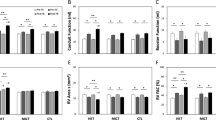Abstract
The effects of various modes of interval hypoxic training differing by the intensity and duration of hypoxic exposure on the morphology and antioxidant status of the heart and lung tissues were studied. Interval hypoxic training mode with more severe, but shorter hypoxic component led to the prooxidant/antioxidant imbalance in the myocardial and lung tissues, which was paralleled by significant disorders in their morphology and function. Moderate hypoxic exposure of different duration promoted the maintenance of optimum antioxidant homeostasis and development of compensatory adaptive changes in tissue structure.
Similar content being viewed by others
References
V. Ya. Karupu, Electron Microscopy [in Russian], Kiev (1984).
A. Z. Kolchinskaya, B. Kh. Khatsukov, and M. P. Zakusilo, Oxygen Insufficiency, Destructive and Constructive Effects [in Russian], Nalchik (1999).
A. Z. Kolchinskaya, T. N. Tsyganova, and L. A. Ostapenko, Normobaric Interval Hypoxic Training in Medicine and Athletics [in Russian], Moscow (2003).
T. G. Sazontova and Yu. V. Arkhipenko, Problems in Hypoxia: Molecular, Physiological, and Medical Aspects [in Russian], Eds. L. D. Luk’yanov, I. B. Ushakov, Moscow (2004), pp. 112–138.
Yu. V. Sudakova, L. E. Bakeyeva, and V. G. Tsyplenkova, Arkh. Pat., No. 2, 15–20 (1999).
Yu. N. Shanin, I. Yu. Shanin, and E. V. Zinovyev, Antioxidant Therapy in Clinical Practice [in Russian], St. Petersburg (2003), pp. 47–53.
M. E. Anderson, Methods Enzymol., 113, 548–555 (1985).
V. L. Kinnula and J. D. Crapo, Am. J. Respir. Crit. Care Med., 167, No. 12, 1600–1619 (2003).
H. Hoppeler and M. Vogt, J. Exp. Biol., 204, Pt. 18, 3133–3139 (2001).
H. Misra and I. Fridovich, J. Biol. Chem., 247, 3170–3175 (1972).
G. T. Saez, W. H. Bannister, and J. V. Bannister, Glutathione: Metabolism and Physiological Functions, Ed. J. Vina, Boca Raton, FL, USA (1990), pp. 237–254.
Author information
Authors and Affiliations
Corresponding author
Additional information
__________
Translated from Byulleten’ Eksperimental’noi Biologii i Meditsiny, Vol. 144, No. 8, pp. 216–220, August, 2007
Rights and permissions
About this article
Cite this article
Gonchar, O.A., Rozova, E.V. Effects of different modes of interval hypoxic training on morphological characteristics and antioxidant status of heart and lung tissues. Bull Exp Biol Med 144, 249–252 (2007). https://doi.org/10.1007/s10517-007-0302-9
Received:
Issue Date:
DOI: https://doi.org/10.1007/s10517-007-0302-9




